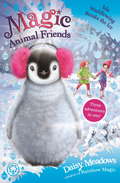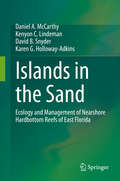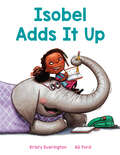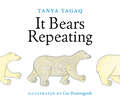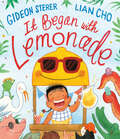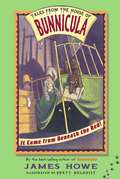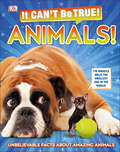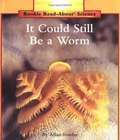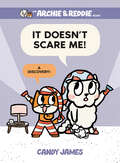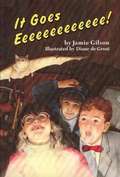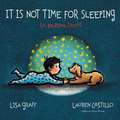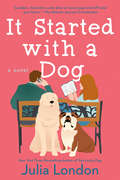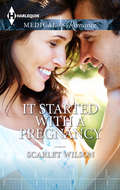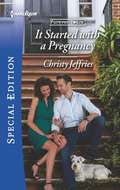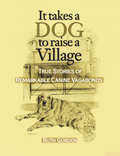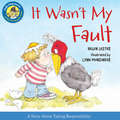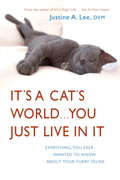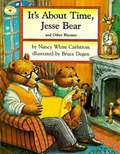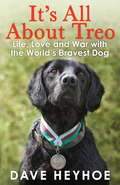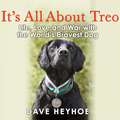- Table View
- List View
Isla Waddlewing Breaks the Ice: Special 7 (Magic Animal Friends #7)
by Daisy MeadowsAn enchanting series full of adorable animals, magic and friendship - from the creator of RAINBOW MAGIC, the UK's bestselling series for girls aged 5-7.In the magical land of Friendship Forest, Lily and Jess are going to a magical Ice Show! But wicked witch Grizelda is planning to spoil the special day with a nasty spell. Can adorable penguin Isla Waddlewing help save Snowdrop Slopes before it melts away?
Island of the Aunts
by Eva IbbotsonAunt Etta, Aunt Coral, and Aunt Myrtle need help caring for the mermaids, selkies, and other creatures who live on their hidden island - and they know that adults can't be trusted. What the kindly old aunts need are a few sensible and sturdy children who can keep a secret. And while kidnapping is generally not a good idea, sometimes it just has to be done. (After all, some kids just plain need to be kidnapped.) When the newly kidnapped assistant caretakers, Minette and Fabio, arrive on the island, all kinds of amazing and wondrous things start happening.
Islands in the Sand: Ecology and Management of Nearshore Hardbottom Reefs of East Florida
by Kenyon C. Lindeman David B. Snyder Daniel A. McCarthy Karen G. Holloway-AdkinsNearshore hardbottom reefs of Florida’s east coast are used by over 1100 species of fishes, invertebrates, algae, and sea turtles. These rocky reefs support reproduction, settlement, and habitat use, and are energy sources and sinks. They are also buried by beach renourishment projects in which artificial reefs are used for mitigation. This comprehensive book is for research scientists and agency personnel, yet accessible to interested laypersons including beachfront residents and water-users.An unprecedented collection of research information and often stunning color photographs are assembled including over 1250 technical citations and 127 figures. These shallow reefs are part of a mosaic of coastal shelf habitats including estuarine seagrasses and mangroves, and offshore coral reefs.These hardbottom habitats are federally designated as Essential Fish Habitats - Habitats of Particular Concern and are important feeding areas for federally-protected sea turtles. Organismal and assemblage responses to natural and man-made disturbances, including climate change, are examined in the context of new research and management opportunities for east Florida’s islands in the sand.
Isobel Adds It Up
by Kristy EveringtonMath-loving kids, especially those who are often bothered by loud noises, will be happy there aren't any elephants around.Isobel is a problem solver . . . addition, subtraction, multiplication, division! But trying to figure out who is causing all the noise next door is one problem she can't quite work out. Is it a marching band? A basketball team in the middle of a practice? Could it be a family of elephants?Isobel doesn't know what to do about all the noise, but the solution just might come from the most unlikely place!
Isoprenoid Synthesis in Plants and Microorganisms
by Michel Rohmer Thomas J. BachIsoprenoids are important in primary and secondary metabolism. They have implications in a myriad of physiological processes notably in plants, microorganisms and parasites, and biological activities at the cellular, organism, and ecosystem levels. The importance of isoprenoids in various areas of the scientific world has spurred intense research worldwide. Also their role in "nutraceuticals" has stimulated scientific curiosity. Literature on isoprenoids is widely scattered in journals with quite differing readerships and geographic distribution. A comprehensive book on isoprenoids does not exist. Isoprenoid Synthesis in Plants and Microorganisms: New Concepts and Experimental Approaches fills this gap by presenting the latest and the most applicable information on isoprenoids. The most recent TERPNET conference serves as the backdrop and provides much of the inspiration for the topics covered in the book. Additional topics of interest are covered as well, making Isoprenoid Synthesis in Plants and Microorganisms: New Concepts and Experimental Approaches the most comprehensive review of isoprenoid synthesis to date.
It Bears Repeating
by Tanya TagaqThis beautifully crafted picture book celebrates one of the world's most awesome animals: the polar bear. Evocative but simple text by award-winning musician and artist Tanya Tagaq is accompanied by striking art in this classic counting book.Beginning with 1 proud polar bear standing tall and ending with 10 bears waving goodbye, this delightful counting book shows polar bears in all their forms: slippery and fast, crafty and cool, hungry and proud. Tanya has created a story meant to be read aloud, incorporating simple Inuktitut words and using her keen ear for the musical sound of language.This book is joyful, powerful, clever and striking — much like the bears who sniff, slide, swim, hunt, play and dance through its pages. And when you get to the last page, you won't be able to resist going back to repeat the journey!
It Began with Lemonade
by Gideon StererFrom New York Times bestselling author Gideon Sterer is an imaginative, colorful tale of making (and selling!) lemonade from life's lemons is not too sour and not too sweet.One scorching hot summer day, a spunky young girl decides to sell lemonade . . . only to find there are too many other young entrepreneurs on her street with the same idea. So she sets off with her lemonade stand and ends up at the river's edge, where she discovers a most unexpected, quirky, and very thirsty clientele.
It Came from Beneath the Bed! (Tales from the House of Bunnicula #1)
by James Howe Brett HelquistDear possible reader of this book,<P> I want to be a writer, just like my uncle Harold, who wrote a bunch of books about our friend Bunnicula. So I wrote this story. And boy! Did I ever get into trouble! My friend Delilah stopped speaking to me because I put her in my book. Uncle Harold stopped speaking to me because I didn’t put him in my book. A writer’s life isn’t easy!<P> But back to my story: It’s about how a talented and lovable (not to mention smart) wirehaired dachshund puppy named Howie saves the world from a disgusting, evil menace named...oops, that would give away the story. But trust me, this menace is disgusting and evil, all right!!!<P> Your friend, Howie
It Can't Be True! Animals!: Unbelievable Facts About Amazing Animals (DK 1,000 Amazing Facts)
by DKPerfect for animal lovers of all ages, this entertaining and wacky book is jam-packed with hundreds of mind-blowing visual comparisons and astonishing facts. Every page reveals incredible information about the weird and wonderful world of animals. Can you believe an ant recently discovered in the treetops of Borneo explodes when under attack, covering enemy ants in a toxic goo? Did you know that the ocean-dwelling bootlace worm is longer than an Olympic-sized swimming pool?"But it can't be true," you say. Yes, it really is!It Can't Be True! Animals bring you record-breaking facts and amazing stories that you can see for yourself. Eye-popping photos and stunning illustrations show you what the numbers mean, comparing the extraordinary with the familiar. From the coconut crab that grows bigger than a basketball to the Ruppell's vulture that soars higher than an airplane, this unique book for kids shows you what other books only tell you.Featuring astounding animals from all the main groups - invertebrates, fish, amphibians, reptiles, birds, and mammals - this is the perfect gift for children who are curious about the animal kingdom.
It Can't Be True! Poo: Packed with Pootastic Facts (DK 1,000 Amazing Facts)
by DKThis book stinks!Hold your nose while you find out absolutely everything you never knew about poo! Did you know that..A week's worth of elephant poo weighs as much a 25 people?A lifetime of farts would fill 2,000 balloons?The world uses enough toilet paper in an hour to wrap around the Earth 14 times?This irresistibly disgusting book for children will teach you all you need to know about all kinds of animal dung and human waste - what it's for, how it's made, where it goes, and lots more! Poo comes in all shapes and sizes. Every animal has its own special sort and some have fascinating uses for it. Wombats use their cube-shaped droppings to mark their territory; potato beetles build a shield of dung for defense; male hippos spray out a fecal shower to attract mates; and rabbits and dung beetles eat their pellets for extra nutrition. We might call it "waste" but in fact, poo is among the most useful stuff on Earth. From building materials and paper to coffee and even water purification, there's a multitude of manure-based matter in our lives.This unique book is jam-packed with scientific explanations and amazing trivia about human and animal deposits. Did you know, for example, that the global population produces more than a million tons of poo every day? Or that an average poo contains 10 trillion bacteria? Or that wars have been fought over guano? All these facts and more are presented, either with jaw-dropping CGI illustrations or eye-popping photography. Additional boxes feature infographics that make information easy to understand. With endlessly interesting information and incredible visuals, It Can't Be True! Poo is the perfect way to entertain and amuse your friends, family, and yourself. In fact, you'll never look at poo in the same way again!"
It Could Still Be A Worm
by Allan FowlerFrom friendly dolphins to giant pandas, from icebergs and glaciers to energy from the sun, from magnets to solids, liquids, and gases, Rookie Read-About Science is a natural addition to the primary-grade classroom with books that cover every part of the science curricula. Includes: animals, nature, scientific principles, the environment, weather, and much more!
It Doesn't Scare Me!: A Discovery! (An Archie & Reddie Book #4)
by Candy JamesElephant & Piggie meets Narwhal and Jelly in this hilarious new early-reader graphic novel series about Archie & Reddie, two fox friends who have wild fun! In this fourth book, when Archie is woken by a scary noise in the night, he turns to Reddie to help him get to the bottom of it.Archie and Reddie are having a sleepover! That means they get to play super fun games all night long and wear their favorite pajamas! And even when a storm knocks out the power, they don&’t get scared. Well, maybe a little at first, so it&’s a good thing they have their trusty flashlights! But when Archie is woken in the middle of the night by a loud grumble, he&’s afraid there might be a monster in the house. Luckily, Reddie is there to remind him of his bravery as the two friends investigate together. Everywhere they look, the noise seems to follow, but they can&’t seem to find a monster anywhere. Is it super-sneaky, or could there be something else causing these late-night grumbles?
It Goes Eeeeeeeeeeeee!
by Jamie GilsonPatrick, the new boy in Richard's class, is always causing trouble, but his work on a science project about bats helps him make new friends.
It Is Not Time for Sleeping
by Lisa Graff Lauren CastilloAs the day comes to an end, bedtime draws near. But the little boy in this book is quite sure it is NOT time for sleeping. As each piece of his evening routine is completed—helping with the dishes, playing with the dog, getting into pajamas, brushing teeth with Dad, being tucked in by Mom, and listening to a story—he becomes a little more certain: it is definitely not time for sleeping. The question is, when WILL it be time for sleeping? A rhythmic, cumulative text and lush twilit scenes come together to create a perfect bedtime book that will be treasured for generations to come.
It Only Looks Easy
by Pamela Curtis Swallow[from the back cover] "In books, when you read something like "everything is great," you just know that something terrible is about to happen. But in real life, you can miss the warnings. And then, wham, slam, sneak attack. Everything skids out of control. BEFORE THE FIRST DAY OF SEVENTH grade is over, Kat Randall's year is nearly ruined. When her beloved dog, Cheddar, is run over by a woman with Alzheimer's disease, Kat reacts impulsively, leaving school on a "borrowed" bike to get to the veterinary hospital. Kat often does the wrong thing for the right reason, but now she has gone from being a person you can count on to someone you probably shouldn't. Suddenly she is looked at differently--by kids in school, the principal, and even the police. If "one of the best years" of her life starts out like this, what's next?"
It Started as an Egg (Fountas & Pinnell LLI Blue #Level G)
by Kimberlee GravesThis book introduces the child to the various animals and insects that hatch from an egg.
It Started with a Dog (Lucky Dog)
by Julia LondonThanks to an accidental phone swap, two adorable rescue pups, and a coffeehouse clash, a holiday flirtation goes to the dogs and hilarity ensues, from New York Times bestselling author Julia London. All Harper Thompson wants for Christmas is the huge promotion she's worked so hard for—which she should get, as long as her launch of the hip new coffeehouse, Deja Brew, goes according to plan. Jonah Rogers is trying to save his family's coffee shop, Lucky Star, from going out of business, which will be tough with the brand-new Deja Brew opening across the street. When Jonah and Harper meet for the first time after accidentally swapping phones, their chemistry is as electric as a strand of Christmas lights. He's a tall, handsome, compassionate hunk of engineer, and she's an entrepreneur whose zest for life is very sexy. They love all the same things, like scary movies, greasy food—and most of all, dogs. It's a match made in heaven...until Jonah finds out that Harper's the one about to put him out of business. Only one coffee shop likely can survive, and a competition of one-upmanship ensues in a battle of the brews. The paws really come out when the local rescue shelter has a fundraiser where local businesses foster dogs, and patrons vote with their dollars for their favorite pup. Harper takes in an adorable old bulldog on behalf of Deja Brew, while Jonah fosters a perky three-legged dachshund for Lucky Star. As the excitement builds for who will be crowned King Mutt and king of the coffee hill, Harper and Jonah must decide if their connection was all steam or if they are the perfect blend.
It Started with a Pregnancy
by Scarlet WilsonDr Cooper Roberts has a new job and the chance to begin a new life. What’s most definitely not in his plans? Waking up with his new colleague, Melissa Bell... And having to hold his head up above the dropped jaws of his fellow docs as he escorts Missy to buy a pregnancy test!
It Started with a Pregnancy (Furever Yours)
by Christy JeffriesIt isn’t puppy love.But when one night leads to babies on the way, is a forever family far behind?Animal rescue director Rebekah Taylor isn’t a pet person—or the family type. But now she’s pregnant and a newbie parent to an adventure-loving stray dog nobody can catch. Kind of like Grant Whitaker, the fancy-free tech consultant who’s not your typical daddy-to-be. Except this dude’s sticking around. Can Grant persuade Rebekah to trust in him and the future they’ve started creating together?
It Takes a Dog to Raise a Village
by Ruth GordonThis collection of true stories celebrates the lives of a handful of vagabond dogs who spurned confinement and one-family ownership.Each dog's tale is unique:Boozer had his own bank account and appeared on Good Morning America; Owney spent his life riding U.S. mail trains and can now be seen in the Smithsonian Institute; Greyfriars Bobby snuck into the cemetery every night for 14 years to sleep on his deceased master's grave; Lampo became famous for riding the railways of Italy but always returned to the same station; Tricksey offered companionship to the residents of a nursing home; Patsy Ann watched the shores of Alaska and knew before all others that a ship was arriving even though she was stone deaf.These atypical dogs all share the same independent spirit that inspires human admiration and devotion.It Takes a Dog to Raise a Village is a tribute to their spirit and their unusual bonds with the humans who knew them.The text is highlighted by pencil drawings.
It Wasn't My Fault (Read-aloud)
by Helen Lester Lynn Munsinger"Lester and artist Munsinger . . . team up again for another rib-tickling, off-the-wall tale." -BooklistMurdley Gurdson is a spectacularly accident-prone boy. He falls into wastebaskets! He drops only the most valuable vases. Worse yet: "Whatever happened, it was usually his fault." One day, as Murdley is taking a walk, a bird lays an egg above him and it splats on his head. How could that really be Murdley's fault? Turns out, it sort of is. Munsinger's hilarious illustrations help make this silly story about cause and effect as lighthearted as it is useful. This read-aloud favorite is now part of a fun hardcover series about life lessons. This ebook includes audio narration as well as a code for free downloadable audio.
It's A Cat's World... You Just Live in It: Everything You Ever Wanted to Know About Your Furry Feline
by Justine A. LeeWritten by 1 of only 177 veterinary board-certified emergency critical care specialists in the world, IT'S A CAT'S WORLD is the follow up to Three Rivers' own It's a Dog's Life, But It's Your Carpet. Together, they are the veterinary equivalents of Why Do Men Have Nipples, humorous reference books for pet owners that provide scientific answers to some of the most common, offbeat questions about our beloved four-legged friends. IT'S A CAT'S WORLD will teach you how to become better pet owner through a deeper understanding of your cat, tips and tricks for changing your cats more irksome habits, explanations for kitty's sometimes bizarre (yet adorable) behavior, advice on training your cat, and how best to look out for her health and well-being so you two can be friends for years to come. Most important, Dr. Lee will reveal what your veterinarian wants you to know about being a smart consumer and pet owner. Some of the questions in the book include: How can I make my anti-social cat less fearful? Why do cats knead your lap before lying down? What's the best way to hold a cat? How can I prevent kitty dreadlocks? Written in a fun, humorous tone with equal parts glibness, passion, and professionalism, IT'S A CAT'S WORLD is sure to entertain and surprise even the most well-informed cat lover.
It's About Time, Jesse Bear and Other Rhymes
by Nancy White CarlstromOften funny, always affectionate poems describe events in a young child's life, such as waking parents, getting dressed, making a mess at the table, and picking flowers for Mama. A darling book for young readers. Other books about Jesse Bear are available from Bookshare.
It's All About Treo: Life and War with the World's Bravest Dog
by Damien Lewis Dave HeyhoeThis is the incredible true story of the unbreakable bond forged between Treo, the world's most highly decorated dog, and his handler Sgt. Dave HeyhoeWhen Dave Heyhoe was sent to Afghanistan to help detect the Taliban's murderous roadside bombs, he knew he'd need a special dog by his side. Luckily for him, his closest pal Treo, a staggeringly brave ball of energy and mischief was with him every step of the way. The two friends had a miraculous understanding that helped them save countless lives but, as they embarked on a roller-coaster emotional ride, Dave realized he needed Treo more than he could ever have imagined. Tear-jerkingly sad one moment, laugh-out-loud hilarious the next, It's All About Treo is a moving and uplifting story that will melt the hearts of animal lovers everywhere.
It's All About Treo: Life and War with the World's Bravest Dog
by Damien Lewis Dave HeyhoeWhen Dave Heyhoe was sent to Afghanistan to help detect the Taliban's murderous roadside bombs, he knew he'd need a special dog by his side. Luckily for him, his closest pal Treo, a staggeringly brave ball of energy and mischief was with him every step of the way. The two friends had a miraculous understanding that helped them save countless lives but, as they embarked on a roller-coaster emotional ride, Dave realized he needed Treo more than he could ever have imagined. Tear-jerkingly sad one moment, laugh-out-loud hilarious the next, It's All About Treo is a moving and uplifting story that will melt the hearts of animal lovers everywhere. (P)2013 Quercus Publishing Plc / WF Howes
